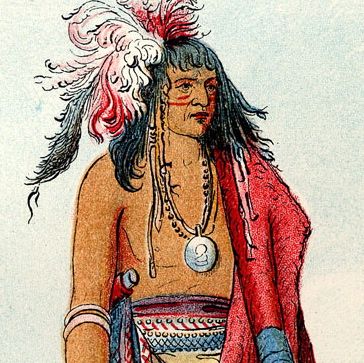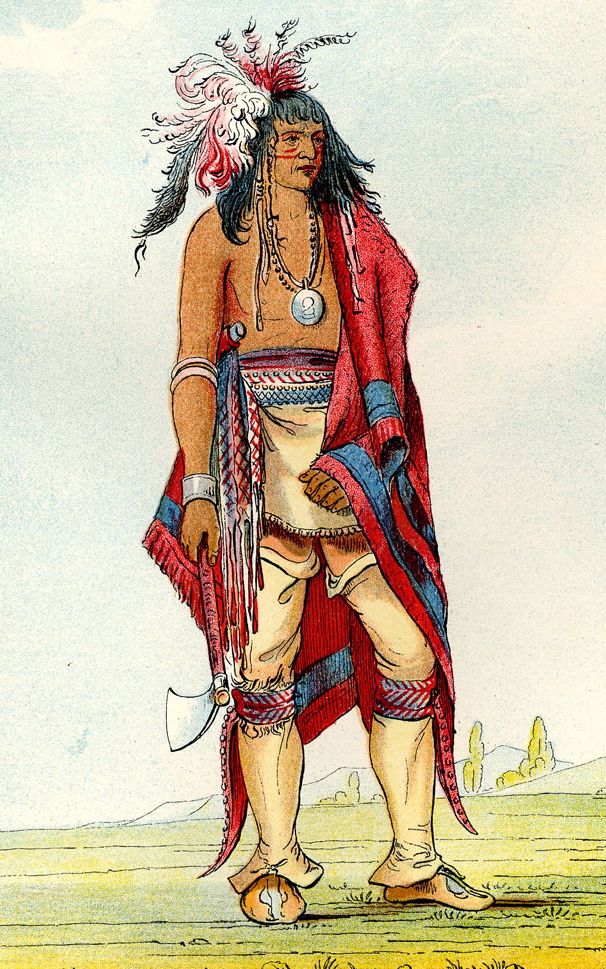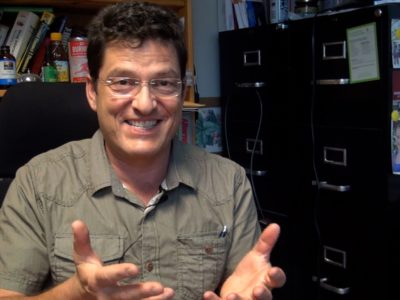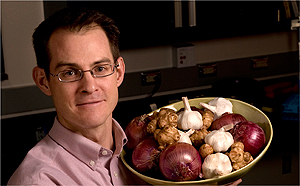Steve Phinney, MD, is one of the medical scientists who has authored New Atkins for a New You. Here’s Steve’s discussion of Pemmican and High fat diets:
Listen to Steve Phinney – 40 Minutes
The Atkins diet has been the bulls-eye for critics. People say it’s unbalanced, it has too much fat, so it must be dangerous. But the thing that has really interested me about low carb diets has been to go back and look at human history. Many of our ancestors before the advent of agriculture — whether agriculture came to us 10,000 years ago, or here among the Native Americans 150 years ago in this turf right here – ate a low carb diet. Our ancestors were called hunter–gatherers and there are a lot of assumptions that they ate a lot of fruit and vegetables, and that’s how they balanced their diet. But it appears in many places (for example here where the buffalo roamed) that those cultures evolved around highly successful hunting skills, with a minimization of and in some cases a complete avoidance of gathering. The natives here on the Great Plains ate mostly buffalo and in many cases nothing but the buffalo and had developed highly evolved cultures around their hunting and food preservation practices.
How did they do it, and were they miserable, stunted, unhealthy sickly people. Or had they found a way to be healthy on a low carbohydrate diet?
George Catlin published this book (Letters and Notes on the Manners, Customs, and Conditions of the North American Indians) initially in 1844. Now Catlin was not an author. He was a painter. He came West with his brushes and sketch pads and pencils, traveling up the Missouri to its headwaters and then down as far south as Texas. Between 1830 and 1836, he lived among native peoples who had little or no contact with European people. He lived among those people, painted them, and wrote a series of lengthy letters describing his experiences. He did 257 paintings and pencil drawings that survive to this day. Women, children, villages, country scenes, burial practices. It’s a rich and original history of native peoples. And what caught my mind, I was looking for details about the diets but didn’t find a lot of quantitative detail. He just seems to assume that everybody understood what these people ate. But he sometimes would live for a year or more among the natives without re-supply on meat and fat and virtually no carbohydrate. He lived off the land as they lived off the land.
If he was eating buffalo, he must have been eating a lot of protein.
He was eating fish, quail, buffalo. We assume that he ate a lot of protein. In actuality, it appears that what the native people did is to time their hunts, and select the animals they hunted for very high levels of body fat. If you killed a buffalo in the fall or early winter, you killed an animal with a lot of body fat. By the way, they generally hunted in small groups. You might have 15-30 people in a hunting party. An adult cow would weigh around 1,000 pounds. A bull would weigh between 2,000 and 2,500 pounds. Now, suppose it’s, say, October? And the daytime temperatures are way above freezing? What do you do with 1,500 pounds of buffalo, and there are only 15 of you?
Once they killed the buffalo they would pitch their tent and go to work on the carcass. They would skin the carcass and they would work with the skin. They would cut the meat and dry most of it, and they would cut away and save the fat. Within 2 or three days they would have pretty much dealt with the whole carcass. They would take the fat and cook it into liquid fat. They would sew sacks out of part of the hide with the hair on the outside and the rawhide skin on the inside, and they would stuff pounded dried meat into the sacks, and then they would take hot buffalo fat and pour it in to fill in all the air spaces around the meat. Pouring it in hot and then sewing the sack closed with no air killed any bacteria, so when it was cooled, you’d have a solid block of sterilized meat and fat. And that was called pemmican.
Pemmican once it was produced in that way could be transported and stored anywhere from six months to five years. Depending on how the pemmican was prepared and when the buffalo was harvested.
So, for a week after the successful hunt, they and their dogs would be eating from the carcass in that first week. Eating the fresh meat, eating the marrow from the bones, which was both a rich source of calcium and minerals as well as fat. Then they’d pack up and leave with maybe 150 pounds of pemmican. And a human could live on one pound of pemmican per day, as a sustenance food
Basically what they could do, if they killed one buffalo per month, a band of 15 people to 30 people could live on that, carrying the stored food and eating the stored food as they traveled. And if they were very successful and killed 10 buffalo in one month, they would be burdened with 1,000 pounds of food. But that thousand pounds of high energy food could then be used to feed them for a hundred days.
If this is all well-known, what about this made you want to dig into it more closely?
If you look deep in the nutrition literature, Pemmican as a storage food during periods of poor hunting was well known. Pemmican was also used as the primary food for the people who transported furs for the Canadian Northwest Company. If you had people whose job was to paddle canoes full of fur for a thousand miles, you didn’t want them to spend all their time hunting and fishing for food. So the Northwest Company purchased pemmican made by the native people of the upper Midwest, the Lakota and Chippewa nations, that was their main source of food, and used it to power their fur transport operation through the Great Lakes and down the St. Lawrence.
Again, that history is all well known. But what I was looking for was the composition of this dietary strategy. When people chose the ingredients for this type of food, how much was meat and how much fat. And actually, it appears that it has many more calories from fat than it does from protein. So what they chose to eat was a moderate protein, high fat diet.
What are those ratios?
Back in the day, no one did calorie measurements of those indigenous fools. That said, my estimates, based on the descriptions of how it was made, are 20% to 25% of energy from protein and 75% to 80% as fat.
. . . on a high fat diet!
People of course lived on this with vegetables and salad supplemented, to get their vitamin C, their carbohydrates. Surely they added other things to this diet?
That has always been the tacit assumption that “hunter gatherers” did that. But the accounts of Catlin and others is that different groups of indigenous people had different dietary practices. But some of these indigenous people existed essentially as pure hunters. The Lakota, Dakota and Nakota nations were nomadic peoples who did not farm, they lived on the prairie, and they had very little fruit and vegetables available for most of the annual cycle of the year, and the warrior group of males in particular prided themselves in not eating “women’s food”, by which might be meant gathered plants. The other thing that’s been said about pemmican is that the Natives always put dried berries in pemmican. But the best, longest lasting pemmican was made in the late fall, or early winter, when berries were not readily available. It stands to reason that berries were put in pemmican to please the European customers who were buying it from them. So they would stick in some of the things the Europeans wanted to make it taste less austere, like berries and oatmeal. However, for the natives, the reason why pemmican was made free of vegetable matter was to facilitate long-term storage. If you made it right, you could store it for a year, or up to five years. Which means these people could carry, with 100 pounds of food and ten people in their party, they could carry enough food to get through a couple of weeks with no hunting at all. You did not want to open a bag of pemmican and find out it was spoiled, when you needed it, so they kept it pure. But if they wanted to please the European customers who were buying it from them, they would stick in things the Europeans wanted.
You’re describing some people who were not Esquimos. They were not Inuit. We know this diet is similar to the ones the Inuit used. There have been many arguments among nutritionists who say that The Inuit are genetically special and only they can eat that kind of a high fat diet, and now you’re saying the Native Americans through the Plains area did the same thing.
That’s correct. And not just Native Americans on the Great Plains. I have also been doing a research project with Dr. Jay Wortman in British Columbia. Our observation is that First Nations people who lived along the Pacific Coast from Vancouver all the way north through the Panhandle of Alaska, we find they, again, ate a diet that was probably 25% of energy from protein and upwards to 75% from fat. Up there, again, the berries were only seasonal, and maybe five percent of energy, averaged over the whole year, came from carbohydrate.
And it doesn’t end there. There was an elegant study in the area that is now Kenya, done by a two British scientists; a physician named Orr and a surgeon named Gilks. They studied people who lived in the plateau area of inner Kenya. They studied the K’Kuyu who farmed and ate a mostly vegetarian diet and relatively low protein diet, and they compared them to people nearby–the Masai, the traditional herders who raised cattle and hunted. People looking through old copies of National Geographic have seen picture of the Masai, many of whom were quite tall. Some of the males were 7 feet tall. Gilks and Orr literally measured all the people, literally measured them, with measuring tape. They measured their health status and dental status. They found the average Masai male was six inches taller than a K’Kuyu male. And the average Masai female was three or four inches taller than the average K’Kuyu female. And whereas the Masai males and females had most of their natural teeth, and the K’Kuyu by the time they were in the mid 20s and early 30s had lost something approaching half of their teeth.
What were the Masai eating and what were the K’kuyu eating?
The K’Kuyu were raising vegetables including millet and tubers, for carbohydrate, and some small amount of protein from small animals they hunted, whereas the Masai kept beef cattle and sheep, and they drank milk, they ate meat, and this might seem unpleasant for people not initiated to it, but they drank blood. When they killed an animal they kept the blood or they would prick a vein from a cow and collect a cup of blood and use that as a condiment in their diet. Blood sounds unpleasant but it’s an excellent source of iron, and a good source of protein and other trace minerals.
Particularly for the hunting class of Masai males, the ones who hunted for food and protected the cattle from lions and other predators, it was a cultural practice that they avoided all vegetable food. They prided themselves in never eating anything but blood meat and fat. Based on the descriptions of Orr and Gilks, they were eating . . . About 30% protein and 65% fat.
Is there sugar in milk, is there sugar in blood?
In all the blood circulating in my body there’s about one teaspoon of sugar. Blood is not a rich source of sugar. We talk about blood sugar. Actually, unless you’re a diabetic, the body is very quick about getting sugar out of our blood. That’s true for all mammals. And . . . Yes there’s sugar in milk. Depending on the breed of the cow, It maybe represents about a third of the energy in milk. But it’s not table sugar. It’s lactose. It’s a natural form of sugar. All mammalian milk contains lactose and it’s metabolized somewhat differently than table sugar.
Well, Steve Phinney, in the United States it’s generally well-recognized that whole milk is not very good for people and should be taken down to skim. Is that what the Masai did to make their milk more healthy?
No, they actually treasured the fat in the milk, and the richer the cream the more treasured it was.
Then let’s stop for a moment and look at what was wrong with the Masai. Surely they had health problems. You described a diet for the Masai and Native Americans in the plains . . . They did not have Vitamin C, because they weren’t eating fruit or berries, so they had scurvy?
That was the hypothesis back in the 1920s after Vitamin C was discovered, and when it was found that Vitamin C was predominately found in fruits and vegetables. At that time, an Arctic Explorer named Vilhjalmur Stefansson, lived among the Inuit. He was called a liar for claiming he could stay healthy on a diet of just meat and fat. To salvage his reputation, he allowed himself to be locked up in Belleview Hospital in New York City for most of the calendar year of 1928. Actually, he was only locked up for three months and then monitored closely when he went out. For that whole year he ate a diet consisting of meat and fat which was about 15% protein and 85% fat, a very high fat diet with no fruits and vegetables, no vitamin pills, and he did not develop scurvy.
Did he have Native American Blood? Did he have some special ability to follow this strange diet?
His name, Stefansson, stemmed from his parents, who emigrated from Iceland. He was of pure Icelandic genetic origin. Maybe the Icelandic people who came from Scandinavia are different from other European people, but we don’t think so.
But to address this question, I took a group of European-origin, young, healthy bicycle racers and put them on an Inuit diet for a little over a month. Now the Inuit diet I used was not seal blubber and whale meat, but instead based on market foods we could find in Boston back in the 1970s. We had them eat that diet for a month. We were interested, not in whether they would get scurvy but whether they could function well, physically, on a very low carbohydrate diet. These were highly trained bike racers in the off season, so they weren’t racing. They were just trying to maintain their fitness. They were riding their bikes between 100 and 200 miles a week. The first week on the low carb diet, they kind of struggled on maintaining their training regimen, but after that, they said they their ability to training was the same as before cutting out the carbs. And after four weeks of adapting to the low carbohydrate diet, when we tested them in the performance laboratory, there was no reduction in either peak power or their ability to do relatively high intensity exercise.
Steve Phinney, did you perhaps pick bicycle racers who had more Native American blood in them so they genetically were more able to adapt to this kind of eating?
Just in terms of their surnames . . . A couple of them had English origin surnames, one was Estonian, one had a German surname, and one was pretty pure Greek heritage. So all European but a fairly wide variety.
But let me take this back full circle. We don’t know for sure what role Vitamin C plays in a diet that’s low in carbohydrates. We know Vitamin C counters what we call oxidative stress, oxygen free radicals, and in a recent group of studies published by Jeff Volek at the University of Connecticut, he has demonstrated that when he takes people on a mixed diet and switches them to a low carbohydrate diet, their level of oxidative stress and inflammation goes down. Perhaps people still need Vitamin C on a low carb diet, but they just need less of it because they have less oxidative stress. So perhaps there’s enough when you eat meat, because fresh meat does contain some Vitamin C. Not a lot, maybe a few milligrams. But maybe you don’t need 50 milligrams a day when you’re on low carb. Maybe you only need five or ten. That’s low enough, you can get it from a diet including fresh meat that doesn’t contain fruits and vegetables.
When you say fresh meat, do you mean meat that’s been freshly killed and then you roast it, or do you mean steak tartare, that is raw meat?
Well, most of us don’t overcook our meat, and when pemmican is made, it’s not cooked, it’s air dried. And then hot fat is added only briefly at the end of the process, and we don’t know how much of the anti-scorbutic value, that is Vitamin C like material, persists when it’s made that way. It’s not an answered question. But the weight of evidence at this point is that scurvy is not a problem for people who eat a hunter’s diet, when that hunter’s diet is based on what people ate for thousands of years or perhaps hundreds of thousands of years.
There are a lot of cultures that have raw meat as a sort of condiment.
The Inuit ate raw meat like, seal meat and seal blubber. You know, they would kill the animal and it would freeze and then they would gnaw on it sitting in their igloo dwellings as the raw meat thawed, and they would eat ice cream. It was looked at by Europeans as being uncivilized and yet it may have had an important roll in maintaining their health
But let me come back to an important point here on the Great Plains. In 1830, Catlin said it was rare to find a male of the Cheyenne tribe under six feet tall. Among the Osage people in the Kansas area, few were less than six feet tall, some of them were seven feet tall. Now, George Washington was 6 foot 3, and he was considered one of the tallest people in the colonies. And remember that the people who came to North America, many of them lived by hunting, eating more of this indigenous food than the subsistence, farmers back in England. So if diet influences height, many were probably taller than their brethren in England.
But the point is, George Washington was considered one of the tallest men in the colonies. But being over 6 feet was common on the great plains. There was a chief of the Kiowa Nation painted by Catlin, Katzatoa, who Catlin claims was about 7 feet tall. In Catlin’s painting, he’s robust, absolutely lean, and very tall. He was even by today’s standards a very tall person. These guys could have played in the NBA. So the question is, how did they get to be so tall? Some might claim that it was purely genetic, but it appears to me that this was a result of their diet.
And I like finding hard data. I don’t like people’s estimates or guesses or presumptions. I treat Catlin’s measurements as hard data. But the most fascinating data came from Now Franz Boaz, a pioneer in American anthropology, who did a study of Native Americans in preparation for the 1892 world Exhibition in Chicago. At that time most of these people were confined to reservations, but 30 years before, they had been eating purely their indigenous diet. Boas measured their average heights and he found that Lakota, Cheyenne, and Kiowa males were over an inch taller than the average U-S soldier at the time. Even though in 1892, when they had been pretty well separated from their native diet. Bottom line: it’s evident to me that diet is a significant factor in height and at least in terms of the ability to grow and live through the life cycle, there is no evidence when practiced, based on acquired, indigenous diets, for instance, a culturally evolved hunter’s diet hasn’t any negative effect on growth or well being.
You describe people who were tall. Did they live a long time?
Well, these were stone age people. They were highly evolved in their cultural and linguistic practices. They were not “literate” in our modern sense of the world. They did not have our modern medicines, but when Catlin went among the people 25 years after Lewis and Clark, he met people who had met Lewis and Clark, and those are people who were old enough to remember. And remember, the average lifespan was probably 45 to 50. People lived to their 70’s, but they were unusual. And there were elderly people among the Native Americans as well. There is no evidence that this diet, in and of itself, shortened people’s lives.
Couldn’t this stupendous strength and health and height of these Native Americans be attributed to the fact that they exercised so much.
That’s quite possible. But if you were a subsistence farmer, planting wheat and corn and potatoes, and raising those, you were doing a lot of exercise.
Oh, you mentioned, in that African culture, the Masai, who were hunter gatherers were healthier than the subsistence farmers, who lived basically alongside them, even though both were very physically active.
That’s correct. The Masai women were noted to eat some vegetable material, particular during pregnancy. It would imply some intuitive sense that they had a greater need of minerals during pregnancy. But it was a point of pride among the males to never eat vegetable matter.
Do you have to be an exerciser, somebody who’s physically active to eat this kind of diet without it hurting you?
I think exercise is a secondary factor in this equation, not a primary driver. It appears to me based on the studies I’ve done and what I’ve read, that if you make a transition to a hunter’s diet, there is a brief lag period of a week or so where your body goes, wait a minute, give me a few days to adapt to this sudden change. But after you have a week of consistently following a hunter’s diet, exercise capacity comes back. So to me, this diet does not prevent exercise, but it is not necessary to exercise in order for the diet to be safe.
Many nutritionists say that we need carbohydrates partly to have fiber to avoid constipation. Are people on a hunter-gatherer diet constipated all the time? Do they have bowel problems? That’s a kind of squeamish topic, but it will be on people’s minds.
You have to remember that the best observations, that is the time period when Europeans were interacting with Native People in North America, this was in the Victorian era, and you didn’t talk about those things. That was considered pornography. So unfortunately, we really don’t know.
What about your bicycle riders? Were they constipated all the time. Because . . . .We live in an age where we can talk about these kinds of things, as long as we’re scientific about it.
Let’s go back to basic principals. Why do we need fiber? People think we need fiber for bulk so we have nice, large firm stools and they pass easily. Biochemically, the reason we need fiber is when you’re eating a carbohydrate containing diet, if you want to nourish the lining of the large intestine. We think, you know, we think the blood stream nourishes the intestines. Unh–unh. The primary nutrient for the large intestine comes from the waste material inside the intestine. Bacteria in our fecal matter break down fiber and produce short chain fatty acids, things that are three and four carbons long, and this feeds the cells lining the colon. Well if you’re an Inuit, or a Lakota Souix eating an indigenous diet, and you’re not eating any fiber, where would those short chain fatty acids come from? Well, it turns out that when you’re on a low carbohydrate diet, your body makes these chemical compounds called ketones, and guess what? They’re short chain acids. And unlike blood sugars, which have to be transported through membranes via active transport, the ketones flow throughout the body essentially as free agents. They penetrate all tissues, and it’s very credible that the nutrition for the lining of the colon would come from circulating ketones, making dietary fiber unnecessary for colon health or function.
Not just my bike racers were on low carb diets, but the roughly 3,000 patients that I used a low carbohydrate diets on during the 20 plus years of clinical practice consistently told me they had less colon problems, less concerns about constipation or diarrhea, when they were on a low carb diet, containing very little fiber, compared to a fiber rich, “optimum balanced” diet.
And your rationale is, this was feeding the microbes in our gut. And that was creating enough bulk to have healthy stools that kept the colon clean and the intestines clean.
It’s not so much the bulk. It’s the quote, happiness, of the lining cells of the colon. If the cells lining your colon are happy, it’s going to function well. It doesn’t matter whether you produce four cups of stool a day or one cup of stool a day. It’s going to be the right consistency. It’s going to be easy to pass. You know, the Inuit didn’t have outhouses. The Inuit lived for at least half the year in a very hostile climate. I guarantee they did not poop inside their igloos.
And they did not have magazine racks in their outhouses because they were sitting there a long time. They did not have that.
They did not have heated toilet seats either. The people who lived in the Arctic, the Inuit, based on archeological records they lived there for three thousand years, and they figured it out. They could probably get their duty done in a brief period of time and not have to worry about straining or whatever, or waiting a long time.
Or diarrhea. Or all of the other complaints that are so common today.
They did not have a rich supply of toilet paper there.
Let’s move on to another topic here.
Yes, let’s do.
Aneurysms. That’s where blood vessels or arteries in the body swell up, lose their integrity and break. Udo Erasmus. His statement to me was that, among the Inuit, one problem they did have, because they were low on Vitamin C, is a more likely tendency to have problems with arteries and blood vessels breaking inside their bodies because they did not have enough Vitamin C to maintain the integrity of those. They were slightly deficient and that was a more common problem. Is that the case for people on this kind of diet. They’re more prone to aneurysms?
There are reports that the Inuit had a higher incidence of stroke, which is brain damage due to plugged or broken blood vessels. We didn’t do modern epidemiological studies until about 50 years ago. But it would appear, when medical missionaries went among the Inuit, living on their indigenous diet, they rarely reported cases of cancer, even though people lived into their sixth or seventh decade. Well documented. Heart disease, heart attack, was rare or unknown. And we know that the omega-3 fats that the peoples got from cold water ocean fish, protect and reduce the risk of heart attack.
Dr. Volek has done studies with non-indigenous foods, that is our current market foods and putting people on low-carbohydrate foods, in his case, the Atkins diet, and demonstrates that inflammation goes down quite markedly, biomarkers, blood materials that are signs of inflammation, go down markedly, when you take people off of carbohydrates and put them on a properly balanced, that is moderate protein, relatively high fat diet. And inflammation has for the last decade been a darling of scientists interested in studying what causes heart attack, and a recent definitive study done a year ago, called the Jupiter study, clearly demonstrates that when you reduce inflammation. Not cholesterol. Inflammation.
That’s C-Reactive Protein, among other things.
C-Reactive protein, Interleukin 6. V-Cam I Cam. There’s a whole salad of different chemicals we test to measure for inflammation. Reduction of inflammation is directly and rapidly associated with reduction of heart attack risk. So yes, there may be some side effects of the low carb diet in terms of vascular health of the brain. Tying it to Vitamin C I think is a bit presumptuous. Because, you said, Dr. Urasmus?
Udo Erasmus
Where did he get his data? Were those people completely free of carbohydrate in their pristine indigenous condition, or were they getting carbohydrates in trade? And eating partially native foods, and kind of in between?
Dr. Volek’s study was done using the Atkins diet, which contains a considerable volume of vegetables but was still quite low in total carbs. I don’t think that absolutely every kind of “low carb” diet is safe, simply because it has a low carb label. I think low carbohydrate diets that are built around indigenous experience have the proof of time, and they provide islands of safety. In the same way that if you want to go on vacation and fly to Hawaii, you don’t fly halfway there and land, to see if it’s getting better. You go all the way and land. There may be islands of safety within the high carb high fruit and vegetable arena. There may be islands of safety in the area of moderate protein, not high protein, moderate protein and relatively high fat. And the space in between, the kind of fifty-fifty, kind of half on an indigenous diet and half off, may actually be much more dangerous than either of the islands of safety at the ends of the spectrum.
Well, Steve Phinney, if somebody wanted to try this kind of diet, this very extreme diet to most people’s point of view, are you saying it wouldn’t be so good to eat this way five days a week. And then have a weekend of fun and celebration with ice cream and pizza?
Absolutely.
Absolutely do that?
Absolutely not
All the evidence from other people’s studies and from my own research is that the human body loves consistency and does not like inconsistency. When you started out this interview, you mentioned we have a book coming out. It’s a revised version of the Atkins diet. He’s not here to write this, so along with myself we’ve recruited two other excellent medical scientists
With all due respect to Dr. Atkins, the amount of science expertise that you and Dr. Westman and Dr. Volek have is actually deeper than Dr. Atkins.
That’s correct. Science. Modern science. And we think we’ve brought current medical science. But what Dr. Atkins brought to the diet was, in a way, similar to what a Lakota or Kiowa grandmother brought to this. Dr. Atkins treated thousands of patients on this diet. And he had, I think, an excellent empiric body of observation. And he basically evolved a diet that worked well for the purposes of his time, which was to help people relatively easily and healthfully lose weight. What we’ve done with The New Atkins for the New You is move beyond there. I’ve brought some key learning from indigenous diets. And the use and selection of fats. Drs. Volek and Westman have added their clinical and research expertise, particularly concerning metabolic syndrome and type 2 diabetes and high blood pressure. And it is a diet that is sustainable, not for a few weeks or a few months, but for decades, to allow people to remain healthy and functional








12 comments for “Steve Phinney on Pemmican and Indigenous Diets”